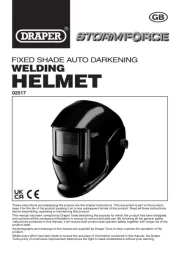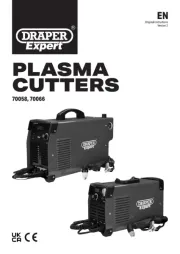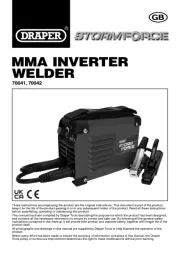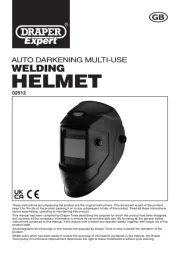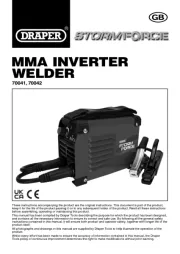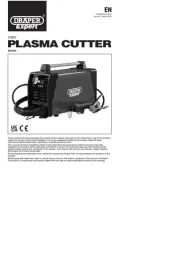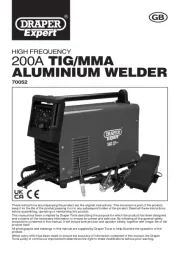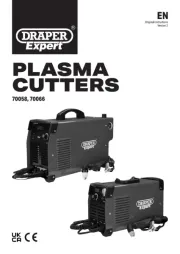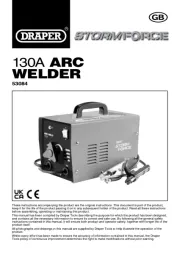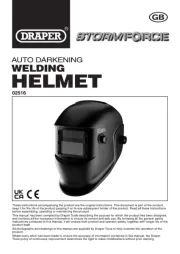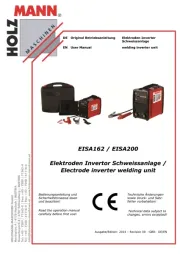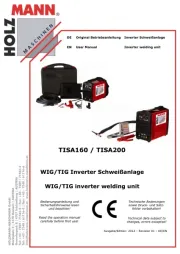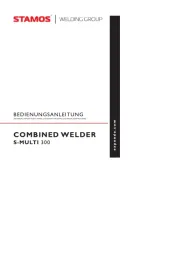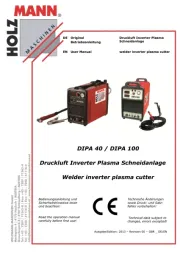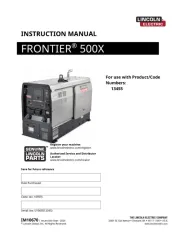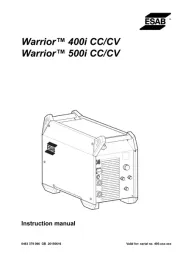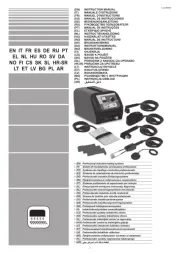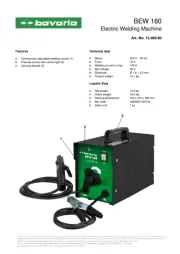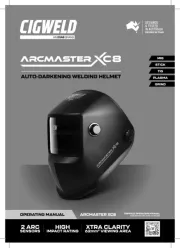
8. PREPARING THE PLASMA CUTTER
6. TECHNICAL DESCRIPTION
6.1 IDENTIFICATION
Draper Tools Limited, Hursley Road,
Chandler’s Ford, Eastleigh, Hampshire. SO53 1YF. U.K.
Draper Tools Europe B.V.
Oude Graaf 8, 6002 NL, Weert, Netherlands
Helpline: (023) 8049 4344
Sales Desk: (023) 8049 4333
Internet: drapertools.com
E-mail: sales@drapertools.com
General Enquiries: (023) 8026 6355
Service/Warranty Repair Agent:
For aftersales servicing or warranty repairs, please contact the
Draper Tools Helpline for details of an agent in your local area.
©Published by Draper Tools Limited.
No part of this publication may be reproduced, stored in a retrieval system or transmitted in any form or by any means,
electronic, mechanical photocopying, recording or otherwise without prior permission in writing from Draper Tools Ltd.
CONTACTS
YOUR DRAPER STOCKIST
KCKC0819
2. CONTENTS
1 TITLE PAGE
1.1 INTRODUCTION .........................................................................................................2
1.2 REVISION HISTORY ...................................................................................................2
1.3 UNDERSTANDING THIS MANUAL ............................................................................2
1.4 COPYRIGHT NOTICE .................................................................................................2
2 CONTENTS
2.1 CONTENTS..................................................................................................................3
3. WARRANTY
3.1 WARRANTY.................................................................................................................4
4. INTRODUCTION
4.1 SCOPE.........................................................................................................................5
4.2 SPECIFICATION .......................................................................................................... 5
4.3 HANDLING AND STORAGE........................................................................................5
5. HEALTH AND SAFETY INFORMATION
5.1 GENERAL POWER TOOL SAFETY WARNINGS.....................................................6-7
5.2 ADDITIONAL SAFETY INSTRUCTIONS FOR CUTTING ......................................7-10
5.3 CONNECTION TO THE POWER SUPPLY................................................................ 10
6. TECHNICAL DESCRIPTION
6.1 IDENTIFICATION ....................................................................................................... 11
7. UNPACKING AND CHECKING
7.1 PACKAGING ..............................................................................................................12
7.2 WHAT’S IN THE BOX................................................................................................. 12
8. PREPARING THE PLASMA CUTTER
8.1 GENERAL .................................................................................................................. 13
8.2 CONTROLS & INDICATORS .....................................................................................14
8.3 WORK PIECE AND WORK AREA SET UP................................................................14
8.4 ATTACH AIR HOSE TO BACK OF UNIT....................................................................14
8.5 ATTACH EARTH CLAMP........................................................................................... 15
8.6 ATTACH TORCH........................................................................................................15
9. BASIC PLASMA CUTTER OPERATIONS
9.1 TORCH ASSEMBLY................................................................................................... 16
9.2 OPERATING INSTRUCTIONS .................................................................................. 17
10. MAINTENANCE ......................................................................................................................18
11. TROUBLESHOOTING
11.1 TROUBLESHOOTING ..........................................................................................19-20
12. OPTIONAL ACCESSORIES
12.1 OPTIONAL ACCESSORIES.......................................................................................21
13. DISPOSAL
13.1 DISPOSAL.................................................................................................................. 22
14. EXPLANATION OF SYMBOLS
14.1 EXPLANATION OF SYMBOLS .................................................................................. 23
DECLARATION OF CONFORMITY .............................................................................. ENCLOSED
1. TITLE PAGE
1.1 INTRODUCTION:
USER MANUAL FOR: 230V Plasma Cutter
Stock No: 92454
Part No: IPC25
As our user manuals are continually updated, users should make sure that they use
the very latest version.
Downloads are available from: http://drapertools.com/manuals
Draper Tools Limited Draper Tools Europe B.V.
Hursley Road Oude Graaf 8
Chandler’s Ford 6002 NL
Eastleigh Weert
Hampshire Netherlands
SO53 1YF
UK
Website: drapertools.com
Product Helpline: +44 (0) 23 8049 4344
General Fax: +44 (0) 23 8026 0784
1.3 UNDERSTANDING THIS MANUALS SAFETY CONTENT:
WARNING! – Information that draws attention to the risk of injury or death.
CAUTION! – Information that draws attention to the risk of damage to the product or
surroundings.
1.4 COPYRIGHT © NOTICE:
Copyright © Draper Tools Limited.
Permission is granted to reproduce this publication for personal and educational use
only. Commercial copying, redistribution, hiring or lending is prohibited.
No part of this publication may be stored in a retrieval system or transmitted in any
other form or means without written permission from Draper Tools Limited.
In all cases this copyright notice must remain intact.
1.2 REVISIONS:
5. HEALTH AND SAFETY INFORMATION
5.1 GENERAL POWER TOOL SAFETY WARNINGS
WARNING Read all safety warnings, instructions, illustrations and specifications provided
with this power tool. Failure to follow all instructions listed below may result in electric shock, fire
and/or serious injury.
Save all warnings and instructions for future reference.
The term "power tool" in the warnings refers to your mains-operated (corded) power tool or
battery-operated (cordless) power tool.
Work area safety
Keep work area clean and well lit. Cluttered or dark areas invite accidents.
Do not operate power tools in explosive atmospheres, such as in the presence of
flammable liquids, gases or dust. Power tools create sparks which may ignite the dust or fumes.
Keep children and bystanders away while operating a power tool. Distractions can cause you
to lose control.
Electrical safety
Power tool plugs must match the outlet. Never modify the plug in any way. Do not use any
adapter plugs with earthed (grounded) power tools. Unmodified plugs and matching outlets will
reduce risk of electric shock.
Avoid body contact with earthed or grounded surfaces, such as pipes, radiators, ranges
and refrigerators. There is an increased risk of electric shock if your body is earthed or grounded.
Do not expose power tools to rain or wet conditions. Water entering a power tool will increase
the risk of electric shock.
Do not abuse the cord. Never use the cord for carrying, pulling or unplugging the power
tool. Keep cord away from heat, oil, sharp edges or moving parts. Damaged or entangled
cords increase the risk of electric shock.
When operating a power tool outdoors, use an extension cord suitable for outdoor use. Use
of a cord suitable for outdoor use reduces the risk of electric shock.
If operating a power tool in a damp location is unavoidable, use a residual current device
(RCD) protected supply. Use of an RCD reduces the risk of electric shock.
Personal safety
Stay alert, watch what you are doing and use common sense when operating a power tool.
Do not use a power tool while you are tired or under the influence of drugs, alcohol or
medication. A moment of inattention while operating power tools may result in serious personal
injury.
Use personal protective equipment. Always wear eye protection. Protective equipment such
as a dust mask, non-skid safety shoes, hard hat or hearing protection used for appropriate
conditions will reduce personal injuries.
Prevent unintentional starting. Ensure the switch is in the off-position before connecting to
power source and/or battery pack, picking up or carrying the tool. Carrying power tools with
your finger on the switch or energising power tools that have the switch on invites accidents.
Remove any adjusting key or wrench before turning the power tool on. A wrench or a key left
attached to a rotating part of the power tool may result in personal injury.
Do not overreach. Keep proper footing and balance at all times. This enables better control of
the power tool in unexpected situations.
Dress properly. Do not wear loose clothing or jewellery. Keep your hair and clothing away
from moving parts. Loose clothes, jewellery or long hair can be caught in moving parts.
If devices are provided for the connection of dust extraction and collection facilities, ensure
these are connected and properly used. Use of dust collection can reduce dust-related hazards.
Do not let familiarity gained from frequent use of tools allow you to become complacent
and ignore tool safety principles. A careless action can cause severe injury within a fraction of a
second.
5. HEALTH AND SAFETY INFORMATION
Power tool use and care
Do not force the power tool. Use the correct power tool for your application. The correct
power tool will do the job better and safer at the rate for which it was designed.
Do not use the power tool if the switch does not turn it on and off. Any power tool that cannot
be controlled with the switch is dangerous and must be repaired.
Disconnect the plug from the power source and/or remove the battery pack, if detachable,
from the power tool before making any adjustments, changing accessories, or storing
power tools. Such preventive safety measures reduce the risk of starting the power tool
accidentally.
Store idle power tools out of the reach of children and do not allow persons unfamiliar with
the power tool or these instructions to operate the power tool. Power tools are dangerous in
the hands of untrained users.
Maintain power tools and accessories. Check for misalignment or binding of moving parts,
breakage of parts and any other condition that may affect the power tool’s operation. If
damaged, have the power tool repaired before use. Many accidents are caused by poorly
maintained power tools.
Keep cutting tools sharp and clean. Properly maintained cutting tools with sharp cutting edges
are less likely to bind and are easier to control.
Use the power tool, accessories and tool bits etc. in accordance with these instructions,
taking into account the working conditions and the work to be performed. Use of the power
tool for operations different from those intended could result in a hazardous situation.
Keep handles and grasping surfaces dry, clean and free from oil and grease. Slippery
handles and grasping surfaces do not allow for safe handling and control of the tool in unexpected
situations.
Service
Have your power tool serviced by a qualified repair person using only identical
replacement parts. This will ensure that the safety of the power tool is maintained.
5.2 ADDITIONAL SAFETY INSTRUCTIONS FOR CUTTING
Warning: When using electric tools basic safety precautions should always be followed to reduce
the risk of fire, electric shock and personal injury including the following.
Read all these instructions before attempting to operate this product and save these instructions.
ELECTRIC SHOCK CAN KILL:
- Remove the plug from the socket before carrying out adjustment, servicing or maintenance.
- Allow 5 minutes waiting time for the capacitors to discharge before removing the panels for any
maintenance operations
- Do not touch live electrical parts.
- Never use electrode holders or cables with damaged or deteriorated insulation.
- Keep working environment, equipment, cables and clothing free from grease, oil, moisture and
dirt.
- Ensure machine has been correctly earthed and all panels are fitted securely.
- The operator must be insulated from the floor and work bench using a dry insulation mat.
- Wear isolating footwear and gloves that are in good condition, i.e. without holes.
- In hazardous conditions of increased electric shock always ensure a second person is present
in case of accident.
- Never change electrodes with bare hands or damp gloves.
- Keep welding cables away from power cables.
- Regularly inspect the condition of the cutting, earth and power cables for signs of damage.
5. HEALTH AND SAFETY INFORMATION
5. HEALTH AND SAFETY INFORMATION
5. HEALTH AND SAFETY INFORMATION
7. UNPACKING AND CHECKING
8. PREPARING THE PLASMA CUTTER
8. PREPARING THE PLASMA CUTTER
8.2 CONTROLS & INDICATORS
Power Switch
(13)
: is on back side of machine.
Current adjustment dial
(8)
: Allows you to adjust the
current from 10 to 25 Amps.
Green LED Light
(2)
: When illuminated, means the
Plasma Cutter is on.
Red LED Light
(3)
: When illuminated, means
cutting is in process.
Yellow LED Light
(4)
: When illuminated, means the
Plasma Cutter has become overheated and the unit
will automatically shut down. Stop using the Plasma
Cutter while leaving the Power Switch ON to allow
the Cooling Fan to operate. The LED Light will turn
off automatically when the unit cools down and then
you may resume cutting.
Dial
(9)
can be pulled to release the lock and then
can be rotated to select air pressure. Once the
correct air pressure is selected press the cap to lock
it in place.
8.5 ATTACH EARTH CLAMP
With the lug on the pin at top, push the connector
(20.1)
fully into the port
(1)
then turned clockwise
180º to lock hand tight only.
8.6 ATTACH TORCH
To connect the torch trigger
(17)
, align the 2 pins
and push to fit, then secure using the outer metal
ring screwing it onto trigger port
(6)
.
The torch hose
(16)
is a push fit into port
(5)
with a
screw down securing collar.
Date first published August 2019.
Version 2 - August 2025.
- Do leave machine unattended and remove plug from socket when not in use.
- Do not use cables unsuitable for the amperage.
- Ensure earth clamp is adjacent to cut, secured to bare metal and when not in use is insulated
for safety.
- Keep all equipment well maintained.
- The operator shall prevent gas cylinders in the vicinity of the work piece from becoming part of
the cutting circuit.
FUMES & GASES CAN BE HARMFUL:
- The cutting process generates hazardous fumes as a by product. Inhalation of these fumes is
hazardous to health.
- Keep your head away from the cut to avoid breathing the fumes.
- If cutting in confined spaces ensure adequate ventilation and use a fume extractor.
- Fumes displace oxygen. Danger of suffocation.
- By products of cutting can react with other chemical vapours to produce a toxic/explosive
environment.
WELDING CAN CAUSE FIRE OR EXPLOSION:
- Cutting and allied processes can cause fire and explosions and precautions shall be taken to
prevent these hazards.
- Before starting a cut ensure the area is clear of flammable materials.
- Remove any inflammables to a safe distance, especially substances likely to generate a
dangerous vapour.
- The cutting flame can cause serious burns. Avoid contact with skin.
- Sparks and moulten metal are cast out during cutting. Take precautions to prevent fire igniting
and wear protective clothing.
- Sparks and moulten metal will pass through gaps. Be aware that fire can start out of sight.
Flammables in a locked cabinet may not be safe.
- Do not cut pressurised containers.
- Do not cut tanks, drums or other vessels until they have been correctly cleaned/prepared for
welding.
- Always have appropriate and fully maintained fire fighting equipment suitable for the materials
used and for use in electrical environments available in close proximity at all times.
- Keep clothing free from oil and grease.
- Wear hat, flame-proof apron, woollen clothing, gloves, long sleeve tops with closed neck,
trousers (without turn-ups) to cover nonslip boots.
- Protective head and shoulder coverings should be worn when overhead cutting.
- Avoid taking any fuels with you e.g. cigarette lighters or matches.
- Hot spots and their immediate surroundings should be observed until their temperature has
dropped to normal.
PERSONAL PROTECTION:
- The body should be protected by suitable clothing.
- The use of neck protection may be necessary against reflected radiation.
- Wear safety glasses when chipping, wire brushing, grinding or when near cooling cuts as metal
filings or slag can be thrown up. Fully enclosed goggles are advisable.
- Arc machines generate a magnetic field which is detrimental to pacemaker recipients. Consult
your doctor before going near welding equipment/operations.
7.1 PACKAGING
Carefully remove the product from the packaging and examine it for any sign of damage that may
have happened during shipping. Lay the contents out and check them against the parts shown
below. If any part is damaged or missing; please contact the Draper Help Line (the telephone
number appears on the Title page) and do not attempt to use the product.
The packaging material should be retained at least during the guarantee period: in case the
machine needs to be returned for repair.
Warning! Some of the packaging materials used may be harmful to children. Do not leave any of
these materials in the reach of children.
If any of the packaging is to be thrown away, make sure they are disposed of correctly; according
to local regulations.
7.2 WHAT’S IN THE BOX
As well as the plasma cutter, there are several parts not fitted or attached to it.
- 3 -
- 22 -
- 23 -
- 5 -- 20 -
- 6 - - 19 -
- 15 -
- 16 -
- 17 -
- 7 -- 18 -
- 14 -
- 8 -
- 9 -
- 10 -
- 11 -
- 13 -
- 21 -
- 4 -
(1)
Earth lead connection
(2)
Power indicator light
(3)
Work/in use indicator light
(4)
Overload indicator light
(5)
Trigger connection
(6)
Torch connection
(7)
Air pressure gauge
(8)
Current adjustment dial
(9)
Air adjustment dial
(10)
Carry handle
(11)
Compressed air feed
(12)
Cooling fan
(13)
Mains power switch
(14)
Power cord and plug
- 12 -
3. WARRANTY
3.1 WARRANTY
Draper tools have been carefully tested and inspected before shipment and are guaranteed to be
free from defective materials and workmanship.
Should the tool develop a fault, please return the complete tool to your nearest distributor or
contact
Draper Tools Limited, Chandler's Ford, Eastleigh, Hampshire, SO53 1YF. England.
Telephone Sales Desk: (023) 8049 4333 or Product Help Line (023) 8049 4344.
A proof of purchase must be provided with the tool.
If upon inspection it is found that the fault occurring is due to defective materials or workmanship,
repairs will be carried out free of charge. This warranty period covering parts and labour is 12
months from the date of purchase except where tools are hired out when the warranty period is 90
days from the date of purchase. This warranty does not apply to any consumable parts, any type
of battery or normal wear and tear, nor does it cover any damage caused by misuse, careless or
unsafe handling, alterations, accidents, or repairs attempted or made by any personnel other than
the authorised Draper warranty repair agent.
Note: If the tool is found not to be within the terms of warranty, repairs and carriage charges will
be quoted and made accordingly.
This warranty applies in lieu of any other warranty expressed or implied and variations of its terms
are not authorised.
Your Draper warranty is not effective unless you can produce upon request a dated receipt or
invoice to verify your proof of purchase within the warranty period.
Please note that this warranty is an additional benefit and does not affect your statutory rights.
Draper Tools Limited.
- The UV and IR radiation generated by cutting is highly damaging to the eye, causing burns.
This can also affect the skin. Protect the eyes and face.
- The face and eyes shall be protected by suitable welding shields equipped with appropriate
ocular protection filters.
- Where environments are subject to pedestrians and traffic ensure a protective screen is used
to avoid accidental arc glare.
- Do not cut in the vicinity or children or animals and ensure no one is looking before striking up.
- In the cutting environment, damaging levels of noise can exist. Wear hearing protection if the
process dictates.
- Do not touch hot equipment or metal. Allow the cut time to cool, use the correct tool and wear
protective welding gauntlets.
- Wear flame retardant clothing (leather, wool, etc.).
- Take care when adjusting or maintaining the torch that it has had time to cool sufficiently and is
disconnected.
- The arc generates ultra-violet radiation (can damage skin and eyes);
- visible light (can dazzle eyes and impair vision);
- infra-red (heat) radiation (can damage skin and eyes);
- Such radiation can be direct or reflected from surfaces such as bright metals and light coloured
objects.
GAS CYLINDERS:
- Gas cylinders should be located or secured so that they cannot be knocked over.
- Shield gas containers can explode if damaged. Take care when handling.
- Ensure gas cylinders are shut-off when not in use and between operations.
- Take care that no build-up of gas is permitted to form in confined area's.
- Cylinders must be in an upright position at all times during use and storage.
- The gas cylinder must never come in to contact with the electrode.
- Follow the manufacturer's instructions for handling, storing and using the gas bottle correctly
and safely.
- Use the correct equipment to connect the gas bottle to the welding torch.
LIMITATIONS:
- Do not use for;
- operations in severe conditions (e.g. extreme climates, freezer applications, strong magnetic
fields etc).
- operations subject to special rules (e.g. potentially explosive atmospheres, mines etc).
- operations that require ingress protection greater than IPX0, e.g. in rain or snow etc.
GENERAL:
- Training should be sought out in
- the safe use of this equipment;
- the processes;
- the emergency procedures;
- Cutting power sources are not to be used for pipe thawing.
- Take precautions against toppling over, if the power source shall be placed on a tilted plane.
- All equipment should be kept in good working condition, inspected and, when
defective,promptly repaired or withdrawn from service - All equipment should be placed so that
it does not present a hazard in passageways, on ladders or stairways, and should be operated
in accordance with the manufacturer's instructions.
- In the vicinity of an arc, non-reflective curtains or screens shall be used to isolate persons from
the arc radiation. A warning, e.g. a symbol for eye protection, should refer to the hazard of arc
radiation.
5.3 CONNECTION TO THE POWER SUPPLY
(20.1)
(1)
(17)
(6)
*Image is representative only
12. OPTIONAL ACCESSORIES
12.1 OPTIONAL ACCESSORIES
A full range of accessories are available from Draper Tools.
Please visit our website for details:
www.drapertools.com
9. BASIC PLASMA CUTTER OPERATIONS
Note: Under no circumstances must the plasma nozzle be removed or any other work be carried
out on the torch with the machine switched on. Ignoring this precaution could lead to serious burns
or contact with high DC voltages.
If the machine has just been used for cutting, allow the cooling air to stop before switching the
machine off for torch servicing.
The torch should be kept free of slag at all times to ensure the free passage of air.
9.1 TORCH ASSEMBLY
To assemble / dismantle the torch:
1. Invert the torch so the tip points upwards.
2. Unscrew and remove the shield cup.
3. Remove the Tip, swirl baffle and electrode.
4. Ensure the torch head thread is upper most.
5. Fit electrode into end of torch head.
6. Fit swirl baffle onto electrode, ensure is it seated
fully onto the electrode.
7. Fit tip onto the swirl baffle.
8. Fit shield cup and screw on.
The Tip and electrode need replacing when worn.
Indication of wear are a loss off cutting capacity or
that the cut is no longer 90 degrees.
When inspecting the Tip look for erosion of the hole
in the centre of the tip or a build up of metal residue.
When inspecting the electrode look for erosion in
centre of the electrode
9. BASIC PLASMA CUTTER OPERATIONS
9.2 OPERATING INSTRUCTIONS
1. Check all safety instructions have been observed.
2. Check correct air supply is connected.
3. Drain any water from bowl on the filter regulator.
4. Set machine to required current range according to the thickness of metal to be cut.
DO NOT change range while cutting.
Caution: DO NOT attempt to cut material beyond the range specified, as this will damage the
torch.
1. Check the torch consumables are in good condition.
2. Check torch and earth lead connections are tight.
3. Connect return lead to the work piece, using an area free of rust and paint, for a good contact.
4. Connect to mains supply and switch on. The green light will come on.
5. Adjust air pressure to 4.5 Bar.
6. Set the cutting current via the current control, an indication of the setting will be shown on the
digital display
7. Adjust the post gas control, if cutting at a high current setting or making a long cut set the
control near maximum, this will give a longer cool time for the torch.
8. Place the torch at the edge of the work piece with the centre of the tip slightly beyond the edge.
Press the torch trigger. The air will flow after a short delay the arc will ignite. The torch should
be moved steadily along the work piece at a rate slow enough for the metal to be cut right
through in one pass. If the cut penetration is incomplete, then the torch could be damaged.
(While the air is flowing, check it is still 4.5 Bar.)
9. When the cut is complete, release the torch trigger button. The arc will immediately extinguish,
but air will continue to flow for a short time. DO NOT turn the machine off until this cooling air
has stopped flowing as this is necessary to prevent damage to the torch.
PIERCING
When piercing, the torch head should be angled back so as to allow the molten material to escape
to one side. The normal angle of cut can be resumed once the metal has been pierced.
Note: Piercing will reduce the life of the torch consumables.
14.1 EXPLANATION OF SYMBOLS
14. EXPLANATION OF SYMBOLS
WEEE –
Waste Electrical &
Electronic Equipment.
Do not dispose of Waste Electrical
& Electronic Equipment in with
domestic rubbish.
Class I construction
(must be earthed).
13. DISPOSAL
These instructions accompanying the product are the original instructions. This document is part of the product,
keep it for the life of the product passing it on to any subsequent holder of the product. Read all these
instructions before assembling, operating or maintaining this product.
This manual has been compiled by Draper Tools describing the purpose for which the product has been
designed, and contains all the necessary information to ensure its correct and safe use. By following all the
general safety instructions contained in this manual, it will ensure both product and operator safety, together
with longer life of the product itself.
AlI photographs and drawings in this manual are supplied by Draper Tools to help illustrate the operation of the
product.
Whilst every effort has been made to ensure the accuracy of information contained in this manual, the Draper
Tools policy of continuous improvement determines the right to make modifications without prior warning.
Read the instruction manual.
Wear face mask and safety
glasses.
Wear ear defenders.
Wear protective gloves.
Do not abandon into the
environment.
Keep out of the reach of children.
Warning!
10. MAINTENANCE
Note: Remove the plug from the socket before carrying out adjustment, servicing or maintenance.
1. Clear dust from machine at regular intervals use clean dry compressed air, if use in a dirty
environment the machine should be cleaned once a month.
2. Check all connections are clean and tight, if there is any oxidization clean the connection with a
mild abrasive or wire brush.
3. If the machine is not to be used for a long time, store it in the original packing a
dry place.
11. TROUBLESHOOTING
11. TROUBLESHOOTING
FIG.1
FIG.2
8.3 WORK PIECE AND WORK AREA
SET UP
Designate a work area that is clean and well-lit. The
work area must not allow access by children or pets
to prevent injury and distraction.
Route the Power Cord along a safe route to reach
the work area without creating a tripping hazard or
exposing the Power Cord to possible damage. The
Power Cord must reach the work area with enough
extra length to allow free movement while working.
Contact the nozzle of the torch to the work piece,
press the button of the torch until the arc-starting,
then perform the cutting operation.
There must not be hazardous objects, such as utility
lines or foreign objects, nearby that will present a
hazard while working.
A barrier, such as a welding curtain or welding
shroud should be put up to protect others in the
work area and limit the spray of sparks.
8.4 ATTACH AIR HOSE TO BACK OF
UNIT
Connect air hose securely to the hose connector
(11)
ensuring an air tight seal with a hose clamp.
FIG.3
FIG.6
FIG.4
FIG.5
230V
PLASMA CUTTER
92454
13.1 DISPOSAL
– At the end of the machine’s working life, or when it can no longer be repaired, ensure that it is
disposed of according to national regulations.
– Contact your local authority for details of collection schemes in your area.
In all circumstances:
● Do not dispose of power tools with domestic waste.
● Do not incinerate.
● Do not dispose of WEEE* as unsorted municipal waste.
* Waste Electrical & Electronic Equipment.
Quick coupler
Water separation
Nipple
Regulator
Drain daily
Air supply
Air line hose
(15)
Plasma torch
(16)
Torch trigger connector
(17)
Torch connector
(18)
Ceramic shroud
(19)
Earth clamp
(20)
Earth cable
(21)
Chipping hammer/brush
(22)
Shaded glass filter
(23)
Face shield
(24)
Spare ceramic shrouds
(25) Spare tips
(26) Spare rings
(27)
Spare electrodes
(15)
(16)
(17)
(18)
(20)
(19)
(21)
(24)
(23)
(22)
(25)
(27)
Problem Possible Cause Remedy
Plasma arc will
not start.
• Unit not powered up.
• Work clamp connection.
• Air supply is low pressure.
• OC Light on front panel of
unit comes on.
• Torch Assembly / Air flow
• Check mains supply, on/off switch is on.
• Check ground clamp has a good
connection to the material being cut,
clean surface of material if it is dirty or
corroded.
• Check air is flowing from the torch tip with
cut switch pressed. Check the
compressor is maintaining 60psi at the
gauge while cutting is in progress. Check
the regulator fittings have been
assembled properly using PTFE tape.
• Check the cutting tip is not blocked by
molten metal splatter.
• Switch machine off and wait about 2-3
minutes, Switch machine back on. This
can occur if the unit is overheating due to
a high ambient temperature.
• Use 32A cable for power lead extensions,
a standard 13A type is unsuitable if a long
extension is required. If the voltage at the
unit 'dips' below the minimum value as
the arc strikes the unit will turn off and the
OC light will come on.
• Try operating the cutter at 20A set
current, if this is OK then there is a
problem with the stability of the mains
supply to the unit. Use a different power
source or thicker mains cable to connect
to the unit mains lead.
• Check the torch has been assembled
correctly. Note the presence and position
of the swirl ring.
• Wait for air flow to finish flowing before
operating cutting switch. Plasma will not
start if air is already flowing from nozzle
when the cutting switch is pressed.
WARNING: For your own safety, turn the switch off and remove the plug from the power
supply socket.
Important: Please note all repairs/service should be carried out by a qualified person.
11.1 TROUBLESHOOTING
Problem Possible Cause Remedy
Plasma arc stops
while cutting
Sparks are
shooting upward
not downward
through the
material
• Hand too tense,
inadvertently releasing the
cut switch
• Cutting speed too slow
• Torch moved too far away
from material
• Compressor unable to
keep up with air demand
• Plasma arc not piercing
material
• Hold the torch lightly against the material
being cut, don't push down. Try and relax
the hand.
• If all material cut from under the arc the
arc will extinguish.
• Move torch closer to the metal to be cut.
• Check air pressure gauge reading when
cut stops.
• Check air pressure gauge is reading
60psi with cut switch pressed.
• Check torch lead connections at unit and
torch are tight.
• Check torch hose is undamaged.
• Check compressor, give the compressor
time to recover if making long cuts when
using a smaller compressor. Check the
regulator fittings have been assembled
properly using PTFE tape.
• Torch travel speed too fast
• Check grounding clamp is making a good
connection to the material being cut and
is tightly connected at the unit. Clean a
patch of material for clamp if rusty
• Increase current
Important: Please note all repairs/service should be carried out by a qualified person.
(10)
(1)
(5)
(2)
(6)
(7)
(8)
(9)
(13)
(11)
(12)
(14)
(3)
(2) (3) (4)
(8)
(11)
(4)
(26)
8.1 GENERAL
This medium weight, portable cutter requires no special lifting instructions, however it contains
dedicated circuitry and must be handled with care.
Note: Although the Electrode and nozzle are classed as a nonconsumable, it will be consumed by
the cutting process and require eventual replacement.
Read the entire Important Safety Information section at the beginning of this manual including all
text under subheadings therein before set up or use of this product.
Warning: To prevent serious injury from accidental operation:
Turn the Power Switch (13) of the Plasma Cutter to its “OFF” position and unplug the plasma
cutter from its electrical outlet before assembling or making any adjustments to the plasma cutter.
Note: For additional information regarding the parts listed in the following pages, refer to the
Assembly Diagram near the end of this manual.
The air regulator is set external. A male Quick Release Adapter need to be mounted on the Air
Pressure Regulator by user. Attach your compressor’s air supply hose to the Quick Release
Adapter. Then, adjust your compressor to deliver 0.3 to 0.35 MPA compressed air.
During operation, you can regulate air pressure through the Plasma Cutter by adjusting the Knob
located on the Air Pressure Regulator (see 8.2 on page 14).
(9)
(16)
(5)
Original Instructions
Version 2 - August 2025
Caution! Risk of electric shock. Do not open.
This appliance is supplied with an approved plug and cord for your safety.
If the power supply cord is damaged, it must be replaced by Draper Tools, an authorised
service agent or similarly qualified personnel in order to avoid a hazard.
The damaged or incomplete plug, when cut from the cord, shall be disabled to prevent
connection to a live electrical outlet.
This appliance is a Class I
†
appliance and is designed for connection to a power supply
matching that detailed on the rating label and compatible with the plug fitted.
The value of the fuse fitted is marked on the pin face of the plug. Should the fuse need replacing,
use a small plain-slot screwdriver to remove the fuse cover. Ensure the substitute is of the
correct rating, approved to BS 1362 and ASTA or BS Kite marked.
ASTA
BSI
This should only be performed by suitably qualified personnel.
If an extension lead is required, use an approved and compatible lead rated for this appliance.
Follow all the instructions supplied with the extension lead.
Important: ALWAYS follow the extension lead instructions regarding maximum load while the
cable is wound. If in doubt, unwind the entire cable. A coiled extension lead generates heat
which could melt the lead and cause a fire.
†
EARTHED : This product requires an earth connection to protect against electric shock from
accessible conductive parts in the event of failure of the basic insulation.
4. INTRODUCTION
4.1 SCOPE
This Plasma cutting machine is designed with advanced inverter technology, which produces a
stable current while reducing the weight and volume of the overall machine. This machine is
suitable for the cutting of ferrous metals up to and including 8mm thickness. Any other application
is considered misuse.
4.2 SPECIFICATION
Stock no. ................................................................................................................................ 92454
Part no. ................................................................................................................................... IPC25
Input:
Voltage† .........................................................................................................................230V~
Phase ...................................................................................................................................... 1
Frequency ....................................................................................................................50/60Hz
Rated Current Range .....................................................................................................10-25A
Main fuse† .................................................................................................................................. 13A
Air pressure ................................................................................................................. 43.5psi (3bar)
Cutting thickness max.
Clean cut ......................................................................................................................... 5mm
Severance ........................................................................................................................ 8mm
Duty cycle ............................................................................. 25%@25A, 60%@16A, 100%@12.5A
Efficiency ................................................................................................................................... 70%
Insulation class ................................................................................................................................S
Degree of ingress Protection rating ......................................................................................... IP21S
Weight ....................................................................................................................................... 8.9kg
4.3 HANDLING AND STORAGE
– Care must be taken when handling this product.
● Dropping this power tool could have an effect on its accuracy and could also result in
personal injury. This product is not a toy and must be respected.
– Environmental conditions can have a detrimental effect on this product if neglected.
● Exposure to damp air can gradually corrode components.
● If the product is unprotected from dust and debris, components will become clogged.
● If not cleaned and maintained correctly or regularly, the machine will not perform at its best.
